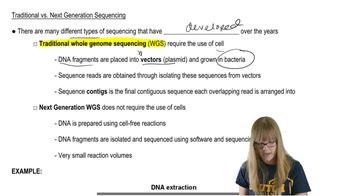As genetic testing becomes widespread, medical records will contain the results of such testing. Who should have access to this information? Should employers, potential employers, or insurance companies be allowed to have this information? Would you favor or oppose having the government establish and maintain a central database containing the results of individuals' genome scans?
Table of contents
- 1. Introduction to Genetics51m
- 2. Mendel's Laws of Inheritance3h 37m
- 3. Extensions to Mendelian Inheritance2h 41m
- 4. Genetic Mapping and Linkage2h 28m
- 5. Genetics of Bacteria and Viruses1h 21m
- 6. Chromosomal Variation1h 48m
- 7. DNA and Chromosome Structure56m
- 8. DNA Replication1h 10m
- 9. Mitosis and Meiosis1h 34m
- 10. Transcription1h 0m
- 11. Translation58m
- 12. Gene Regulation in Prokaryotes1h 19m
- 13. Gene Regulation in Eukaryotes44m
- 14. Genetic Control of Development44m
- 15. Genomes and Genomics1h 50m
- 16. Transposable Elements47m
- 17. Mutation, Repair, and Recombination1h 6m
- 18. Molecular Genetic Tools19m
- 19. Cancer Genetics29m
- 20. Quantitative Genetics1h 26m
- 21. Population Genetics50m
- 22. Evolutionary Genetics29m
18. Molecular Genetic Tools
Methods for Analyzing DNA
Problem 9c
Textbook Question
Which of the examples of genetic testing below are prognostic tests? Which are diagnostic?
DNA sequencing of a breast tumor reveals mutations in the BRCA1 gene.
 Verified step by step guidance
Verified step by step guidance1
Understand the difference between prognostic and diagnostic tests: Diagnostic tests are used to identify the presence of a disease or condition, while prognostic tests predict the likely course or outcome of a disease.
Analyze the context of the example: DNA sequencing of a breast tumor is performed to identify mutations in the BRCA1 gene, which is associated with breast cancer.
Determine if the test is diagnostic: If the sequencing is used to confirm the presence of a BRCA1 mutation in the tumor, it is diagnostic because it identifies a specific genetic alteration linked to the disease.
Determine if the test is prognostic: If the sequencing is used to assess how the BRCA1 mutation might influence the progression, severity, or treatment response of the breast cancer, it is prognostic.
Conclude the classification: Based on the purpose of the test (diagnosis or prediction of disease outcome), classify the example as either diagnostic or prognostic.
 Verified video answer for a similar problem:
Verified video answer for a similar problem:This video solution was recommended by our tutors as helpful for the problem above
Video duration:
3mPlay a video:
Was this helpful?
Key Concepts
Here are the essential concepts you must grasp in order to answer the question correctly.
Prognostic vs. Diagnostic Testing
Prognostic tests are used to predict the likely course or outcome of a disease, while diagnostic tests are designed to confirm the presence of a disease or condition. Understanding the distinction is crucial for interpreting genetic testing results, as it informs treatment decisions and patient management.
Recommended video:
Guided course

Traditional vs. Next-Gen
BRCA1 Gene and Its Role in Cancer
The BRCA1 gene is a critical gene involved in the repair of DNA breaks. Mutations in this gene are associated with an increased risk of breast and ovarian cancers. Identifying mutations in BRCA1 through genetic testing can provide insights into a patient's cancer risk and inform both prognostic and diagnostic evaluations.
Recommended video:
Guided course

Cancer Characteristics
DNA Sequencing
DNA sequencing is a method used to determine the exact sequence of nucleotides in a DNA molecule. In the context of genetic testing, sequencing can identify specific mutations that may be linked to diseases, helping to classify whether a test is prognostic or diagnostic based on the findings and their implications for patient care.
Recommended video:
Guided course

Sequencing Difficulties

 7:40m
7:40mWatch next
Master Methods for Analyzing DNA and RNA with a bite sized video explanation from Kylia
Start learningRelated Videos
Related Practice
Textbook Question
369
views
